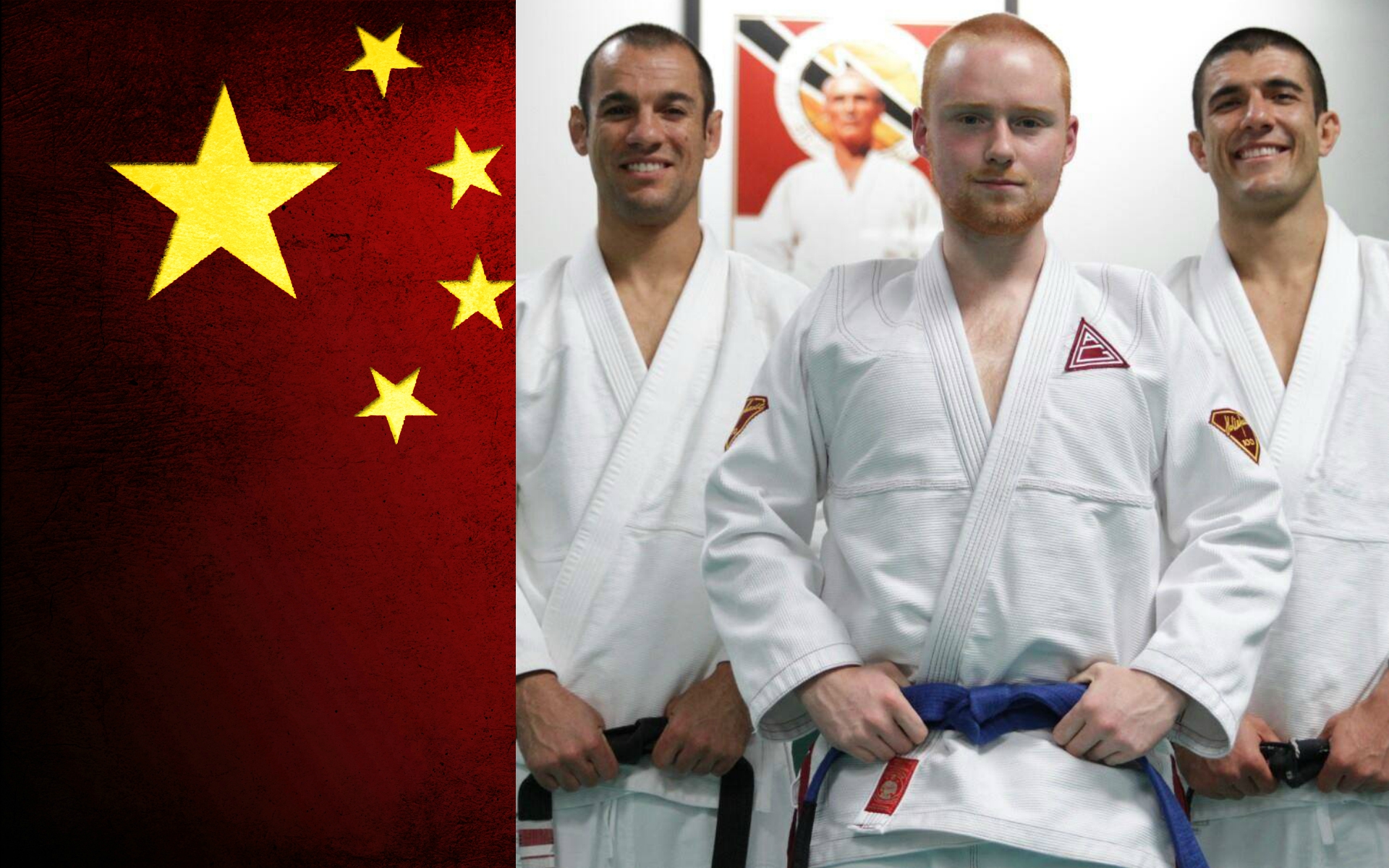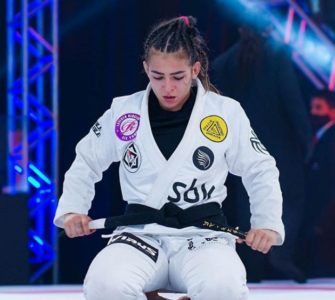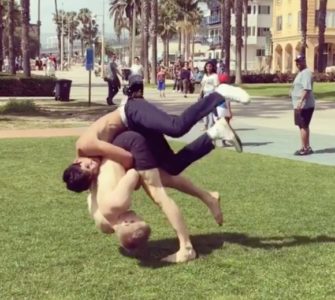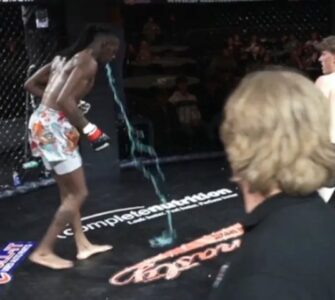Brazilian Jiu-Jitsu is growing all over the world. China, the most populated country in the world with 1,4 billion inhabitants, has also embraced BJJ. China started BJJ relatively late in Asia compared to Japan or the Philippines (mid 90’s). BJJEE did some research with various sources in China, and currently (2016) there are 13 BJJ black belts in China and 16 BJJ black belts in Hong Kong (according to bjj-asia.com). Thomas Fan is the first Chinese black belt in China (promoted in 2011 by Ze Marcelo of Icon). Henry Chan has also been mentioned as being the first Chinese BJJ black belt but the date hasn’t been verified . The BJJ community of China is very tight knit.
List of BJJ black belts in China (not including Hong Kong) according to Chinese BJJ federation:
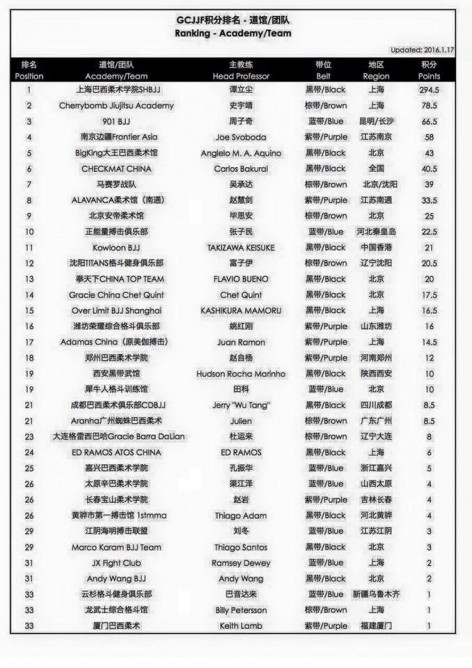
BJJEE was recently contacted by Ferdinand Feiler, the first ever certified Gracie Jiu-Jitsu instructor under the Gracie Academy. Feiler is a blue belt with a background in Kung Fu and has recently opened the first ever Gracie Academy in China. BJJEE wanted to know more about this historic event and we interviewed him and asked him about how he started training, his level of experience, what sets him apart from black belts in BJJ that have been teaching and competing for years, his view on BJJ in China and much more:
1. Ferdinand can you please introduce yourself to the BJJ community
My name is Ferdinand Feiler and I hold a Blue Belt Stripe 1 and am a certified instructor of Gracie Jiu-Jitsu under the Gracie Academy. I started training Martial Arts when I was 15 after I got beaten up by English Football fans in summer 2010. Recently, at age 21, I have opened the only Year Round Residential Gracie Jiu-Jitsu Full Time Immersion Training Camp in the world and to make it even more exiting, it’s also the only Gracie Certified Training Center in China!
2. Please tell us about your Jiu-Jitsu journey
I originally came to China to learn Kung Fu in a residential Kung Fu School but by pure luck, a Gracie Jiu-Jitsu Instructor arrived 3 months after me and introduced me to the gentle art. Richard, who had several decades of experience in Judo and was a certified instructor under the Gracie Academy. He had planned to open China’s first Gracie Certified Training Center but due to a personal tragedy, he was never able to do that. So he called up his old friend at the Residential Kung Fu School and asked if he could teach there.
Training with Richard, I earned my blue belt, and then I moved to another city to commence my academic studies and get proficient in Mandarin Chinese, I of course wanted to continue my GJJ training and thus I choose Kunming over other cities to study Chinese because there was a Sport BJJ Black Belt teaching there 3 days a week. About 3 months after I arrived the club was shut down. So I started teaching my friends in my living room for free because I needed training partners to help me advance. The closest BJJ schools I knew of at that point were in Guangzhou and Thailand, both well over 1000km away.
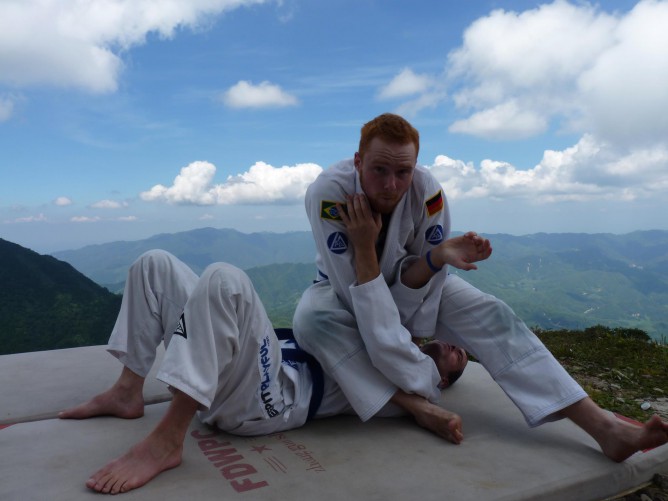
3. How did you end up opening the first Gracie Certified Jiu-Jitsu Training Centre in China?
It didn’t take me long and the Gracie Garage I was running in my living room had accumulated 15 students, all training for free.
At that point I was dedicating about 20 hours a week to learning and teaching Jiu-Jitsu and 20 hours a week to learning Chinese. A year later my girlfriend and I found ourselves slowly but surely running low on money. I still hadn’t even considered opening an actual school until I watched Ryron Gracie fight Andre Galvao in Metamoris 1. I am sure there’s a lot of controversy surrounding this fight but what I saw was a guy who trains specifically for self-defense, surviving against a more athletic guy who trains specifically to win competitions. One of them looked tired and frustrated after the fight and it wasn’t Ryron. What really impressed me is that Ryron did not do any special preparation for the event. He didn’t struggle to increase his bench pressing and didn’t tell his normal students to come back in a week because he only wanted to train with other top black belts. All he did to prepare himself for facing one of the most dangerous grapplers in the world was to teach all day, every day. When I heard him say that, it was like he had just taught me another technique. He taught me that the best way to learn Jiu-Jitsu is to teach it!
There are all sorts of rational reasons as to why to open a BJJ school in China. MMA is the fastest growing sport in the world and there is hardly any grappling in China. The Chinese are crazy about foreign martial arts; Taekwondo is more popular here than Kung Fu is. Surely the Gracies would be supportive of someone picking up the Triangle Standard and carrying it to China. However, most importantly and above anything else, I want to be the best martial artist I can possibly become and Ryron Gracie made me believe that the most efficient path to reach that goal is to become a certified instructor.
3.5. How did you end up also opening the first Residential Gracie Certified Training Center?
If there is another reason to open a school, especially the only residential Gracie Jiu-Jitsu Certified Training Centre, it is that I had never been as happy as when I was living at that Kung Fu school. “Travel the World – Live Jiu-Jitsu” is the slogan I have chosen for my school, exactly because this is what I love most in life.
Unfortunately, the Kung Fu school only offered GJJ temporarily and so I had to arrange for my own training. I love the t-shirt that says: Eat, Sleep, Jiu-Jitsu, Repeat. But most people that wear this t-shirt don’t live by it, they only wish they could. Once we decided to open a GJJ school we immediately knew it would have to be residential. The joy experienced between a group of likeminded people, learning GJJ every day, making their bodies healthier with daily Yoga and stronger through daily fitness routines, all while discovering one of the most alien cultures Westerners can still find in this wonderful world is something I would love everyone to experience! The best part is that since students will get 6 hours of training a day, they can learn in 3 months what might take 8 – 12 months under a typical “three-times-a-week” Jiu-Jitsu training regimen. Imagine how far you’d get if you spent 9 or even 12 months of your Gap Year with us!
To make sure I uphold the quality standards I set for myself as an instructor and the owner of this school, I have invited seven travel bloggers that have never learnt any Jiu-Jitsu before to be my first students. These students don’t pay me anything for their stay here. I sponsor them in return for them to give honest accounts of their time with us. Five of them are already here and will stay for 3 months totaling 160 hours of GJJ training! Check out my Facebook page Gracie Jiu-Jitsu Immersion China for some of the feedback that we’ve gotten thus far.
4. You being a blue belt, how do you intend to grow the academy in terms of credibility with so little actual experience?
As Rener says: “Just because someone is a black belt in jiu-jitsu, doesn’t mean they are black belts in teaching the art.”
When an instructor completes the Gracie Academy Instructor Certification Program and opens a Certified Training Center, not only are they taught which techniques to teach and the order to teach them in, but they are taught EXACTLY how to teach those techniques. Every technique in every lesson has been meticulously planned and laid out into a cyclic curriculum by the Gracie brothers in Torrance, and we, the instructors, are required to maintain that quality standard. So, from a “credibility” perspective, even though some of the instructors at CTCs around the world might not be black belts, the actual techniques being taught are as legitimate as they come, since Ryron and Rener chose the techniques and laid out the perfect roadmap for us and our dedicated students.
5. What are your long term goals for Jiu-Jitsu in China?
Chinese martial arts are woefully out of date. Every single important revolution and civil unrest movement in the history of China was led by martial artists, so during and after the Cultural Revolution, the Communist Party made it a priority to “redirect the energy” of the practicing and teaching of martial arts. They unified all styles of martial arts in a style referred to as Wushu: This is purely performance based and has a lot more in common with ballet than with fighting. In my opinion, there are many good Kung Fu teachers – unfortunately they all had to leave China a long time ago, most of them left through Hong Kong (Bruce Lee) and they opened schools in the West.
That means that China has a terrible lack of real fighting systems (blows your mind after all those Kung Fu movies). The most realistic form of Kung Fu taught in China is Sanda / Sanshou. It’s a form of kickboxing that was invented recently to make sure that China wouldn’t fall even further behind Muay Thai, Taekwondo and American Kickboxing. Sanda incorporates strikes, kicks and takedowns but no knees and elbows. Sanda practitioners tend to be much better at takedowns than Muay Thai fighters because takedowns are awarded many points in a competition. To my knowledge, there hasn’t been a single strong Chinese MMA fighter in the UFC. In fact, MMA is usually translated into Sanda which roughly means “free fight”, so the Chinese often don’t even realize that they are terrible at MMA since they think MMA and Kickboxing are the same thing.
Essentially there is little to no grappling to be found anywhere in China. I’ve heard many great tales about Chinese ground fighting or how a 70 year old Tai Chi master can throw any wrestler he wants but that doesn’t change the fact that I have never seen any grappling in China in 4 years of travelling and studying martial arts. Most people ask me “Is BJJ kind of like Yoga?” – To which I like to reply “Yes! But not voluntarily!” (Nobody gets it).
I would love for Gracie Jiu-Jitsu to be demonstrated to the Chinese the same way that it was demonstrated to the Brazilians, the Japanese and then the Americans. By the Gracies sending the smallest kid in the current fighting generation into a no rules competition, they could help open the eyes of martial artists in the spiritual homeland of martial arts the same way that Royce Gracie opened America’s eyes in 1993. How much that would affect me and my school I am not sure however. I own the only real self-defense school within hundreds of miles so if I do my job well, word will get around whether the Chinese know of BJJ or not.
Food for thought, China has 21 cities with populations over 5 million (compared to 2 in the USA) and more than 150 cities with a population over 1 million (compared to 9 in the USA). I know of 3 BJJ Black Belt Instructors in all of China – What are you all waiting for?! (BJJEE Has found out that are actually over 30 know BJJ black belts in China)
6. What do you think of the Brazilian Jiu-Jitsu scene in China?
The BJJ scene in China is certainly in its very early stages. The day I opened my school I had Taekwondo Black Belts and Sanda fighters from all over the Province (State) show up desperate to learn some actual ground fighting because they heard the real money is in MMA these days. Several of them offered me a job at their schools in other cities, asked for partnerships, summer camps etc. The Chinese currently don’t care about BJJ, nor do they know or understand it. But many of the more modern martial artists can see that the UFC and MMA are where not just glory but also money lies and they’d like a piece of it.
In the few BJJ clubs I have visited in China (I guess there are less than 25 clubs in all of China) so far, about a third of the students tend to be Westerners and the Chinese students tend to all be massively big guys (for Chinese Standards) – so the whole idea of self-defense for weak vs. strong certainly hasn’t gotten though yet.
This is a great article on MMA in China https://dynastyclothingstore.wordpress.com/2013/02/01/where-are-the-chinese-fighters-why-mma-has-not-flourished-in-chinese-society-long-read-with-videos/
7. What do you think Sport BJJ (IBJJF style)?
The first time I got in contact with a Sport BJJ club, the head instructor told me in no uncertain terms that Richard (the best teacher I had ever met and who got me in love with GJJ) was a fraud who shouldn’t be teaching. The Black Belt turned out to be a very friendly guy with nothing but good intentions, but I felt that he lacked understanding of how our system works. His students were all very specialized in certain sport techniques, but none of them had the solid basics that studying Gracie Combatives will give you. There were Blue Belts with 3 years’ experience who couldn’t execute an elbow escape from the mount.
I think Ryron and Rener put it perfectly in this video: https://www.youtube.com/watch?v=e864iZ4sB8Q
8. What’s next for you in 2016?
To continue growing my understanding of Jiu-Jitsu while helping people learn the amazing art of Gracie Jiu-Jitsu who would never otherwise have access. In regards to my Certified Training Center, I need to prove to travelers, gap year students and people interested in self-defense all over the world, that in 3 months, training 6 hours a day, I can teach them more about self-defense than they could have ever imagined. Beyond just an exotic GJJ vacation resort, I want my CTC to be the starting point for world travelers (especially women) who want to learn effective self-defense skills while discovering China.
If anyone is interested in a Gracie Jiu-Jitsu / Self-Defense / Yoga / Cultural Immersion Vacation in the most beautiful province in all of China please visit: http://www.gracie-immersion-china.com/
9. Feel free to thank sponsors or friends
I want to thank Ollie Batts from Cambridge Academy of Martial Arts for getting me interested in Martial Arts and Dave Wagnall from Simply Krav Maga Cambridge for introducing me to more self-defense based styles of training. It was Richard Atkin who is at the moment teaching together with his brother Edward at Grimsby Gracie Jiu-Jitsu that guided me through my first steps of my Jiu-Jitsu journey and without him or Ryron and Rener Gracie who made it all possible I would not be here living my dream!
Message in German for his family: Noch wichtiger, als der Beistand, den ich von den Gracies bekommen habe, ist der Beistand von Zuhause. Ohne meinen Papa, meinen Bruder und die vielen Freunde die ich selten sehe, aber an die ich oft denke und von denen ich nichts als Zuspruch und Rückendeckung erhalte, wäre ich nie so weit gekommen!
Möp

